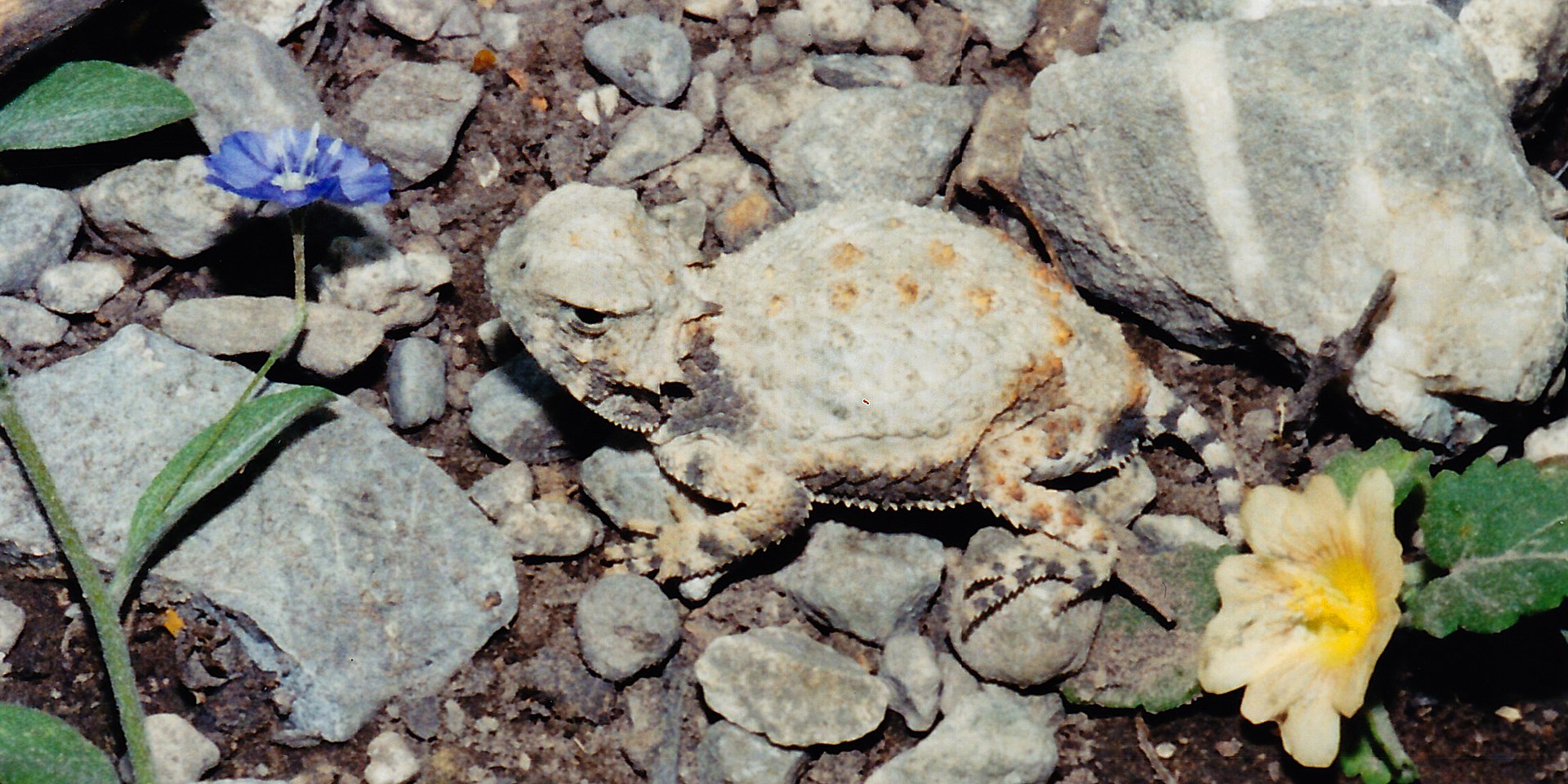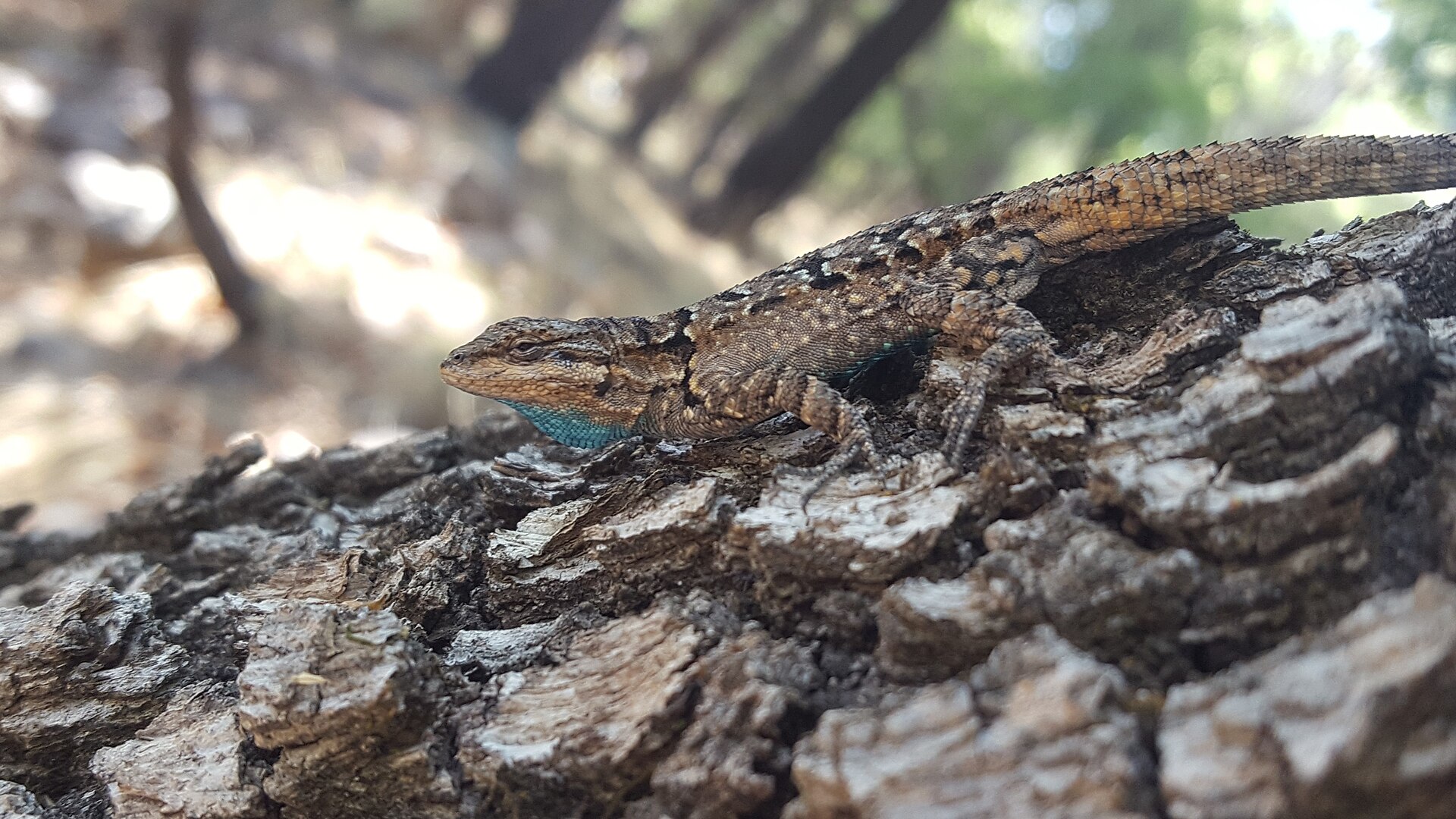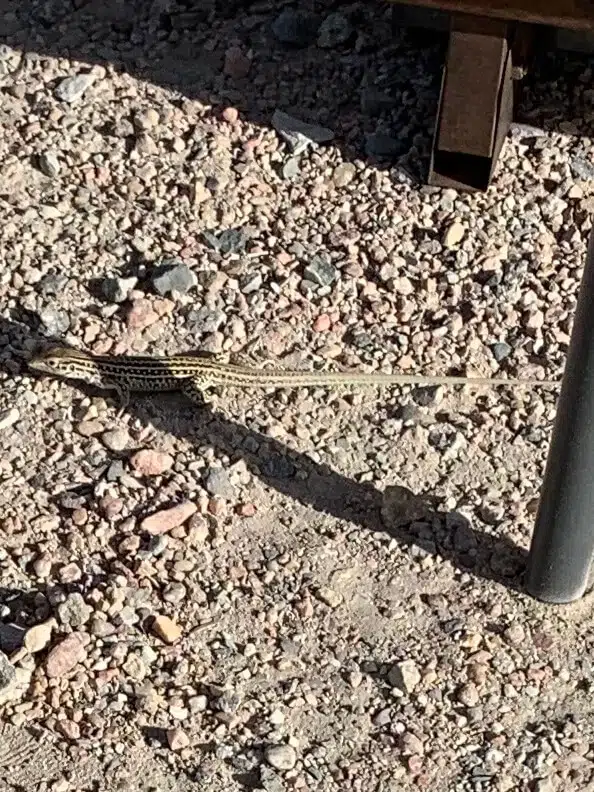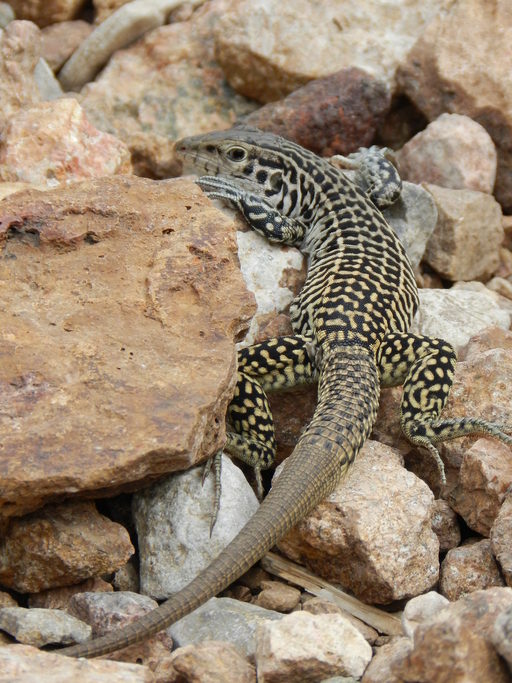Have you just noticed a lizard in your backyard? Has your child or dog just come in with a lizard and you’re worried if it’s poisonous? There are 19 lizards you may come across in Colorado.
Continue reading below for information on these lizards, helping you identify them quickly.
Are there poisonous lizards in Colorado?
The two poisonous lizards you will find in North America are the Gila monster and the Mexican beaded lizard, neither of which you will get in Colorado. These are large lizards with thick bodies and short limbs, living in desert regions.
Most lizards won’t bite unless you try and pick them up. When they do bite, they bite with teeth, hanging onto their victims, making it hard to remove the lizard.
Bites can cause a compression injury, causing swelling and damage to the underlying tissues. It is possible for the skin to split open. Tissues are often damaged by trying to remove the lizard rather than the bite itself.
If you touch any lizard, whether it’s one in your yard or your dog has it in its mouth, you need to wash it immediately. Wash your hands thoroughly if you have handled a lizard and rinse out your pet’s mouth, as lizards are known to carry salmonella.
Lizards in Colorado
The nineteen lizards you will find in Colorado include:
1. Common Collared Lizard

Scientific name: Crotaphytus collaris.
Common name: common collared lizard, eastern collared lizard, Oklahoma collared lizard, yellow-headed collared lizard, collared lizard.
This lizard is often referred as the Eastern collared lizard. It is a North American lizard that has a large head with a powerful jaw.
Collard comes from the coloration of the lizards with black bands around the shoulders and neck that looks like a collar.
Males tend to be colorful and you may find them with blue bodies, yellow stripes, and orange throats. Females are light brown in color.
These lizards can grow up to 15 inches (38cm), which includes the tail.
The common collar lizard can be found in open and dry regions.
2. Long-nosed Leopard Lizard

Scientific name: Gambelia wislizenii.
Common name: Long-nosed leopard lizard.
The long-nosed leopard lizard is a large lizard with a length of around 14.6cm (5.75 inches) from snout to vent. They have a large head, a long round tail that is often longer than the body, and a long nose.
They have granular scales that are often cream, gray, or white with irregular brown or gray spots on the head and body. It’s not uncommon to find them with a dark bar or bars on their backs.
Juveniles are more colorful, often bright red spots can be seen, along with yellow thighs and rusty coloration on their backs.
Females grow to around 5.8 inches (15cm) from snout to vent with the male being smaller, around 4.8 inches (12cm).
Both have marked color change, with their spots barely noticeable when it’s dark and their crossbars become more obvious, when it’s light the spots become more prominent and the bars are hidden.
Females have red to orange spots and bards on their sides during mating season, while males develop ink on their throats and chest.
These lizards prefer dry areas where there is plenty of low plants. They live in sand, gravel, and rocky areas.
3. Lesser Earless Lizard

Scientific name: Holbrookia maculata.
Common name: Western earless lizard, lesser earless lizard.
The lesser earless lizard can be found in the Central and Southwestern United States, along with Northern Mexico.
These small lizards are often found in open habitats in the southern Colorado Plateau. They prefer open plains, though can be found in woodlands and dry regions.
4. Texas Horned Lizard

Scientific name: Phrynosoma cornutum.
Common name: Texas horned lizard.
The Texas horned lizard is one of fifteen North American spiky-bodied reptiles, known as horned lizards. The majority of these species are stable, though there are population declines that have been noted in Texas and Oklahoma over the years.
This is a large-bodied horned lizard and is very widely distributed.
The average size is around 2.7 inches or 6.9cm from snout to vent. Females are larger around 4.5 inches (11cm) with males reaching around 3.7 inches (9cm).
5. Greater Short-horned Lizard

Scientific name: Phrynosoma hernandesi.
Common name: Greater short-horned lizards, mountain short-horned lizard.
The greater short-horned lizards are another of the horned lizards that can be found in Colorado and often confused as the pygmy short-horned lizard. These lizards are actually considered distinct as the pygmy occupies their habitats.
These lizards range in size from two to five inches (5 to 12cm) from snout to vent.
They are flat bodies and very squat lizards with short spines on their heads. They can be identified for their short legs and snub-nosed profiles. Their trunk has a row of pointed scales with smooth belly scales.
Their colors range from red-brown to gray or yellow with two rows of large dark spots, which are located on their backs. Their colors intensify when they feel threatened or show aggressive behaviors.
As with most lizard species, the females are larger than the males.
Females tend to grow to around 2.75 inches (7cm), while males grow to two inches or 5cm.
The average weight is around 10 grams and their maximum length with the tail can reach around six inches (15cm).
6. Roundtail Horned Lizard

Scientific name: Phrynosoma modestum.
Common name: roundtail horned lizard.
This is a small species of horned lizard that prefers a sandy or rocky habitat, semi-arid habitats and very sparse vegetation. You can often find them near ant, and harvester ant colonies, which make up the majority of their diets.
These lizards reflect the color of the soil, mainly gray to light brown in color, some a pale yellow. The neck and groin tend to be darker in color. Some have stripes on their tails.
They have rounded flat bodies with short limbs and small heads. The head is a crest of equal length horns. When they camouflage themselves, they hunch up their bodies to imitate a rock.
These lizards grow to around 2.7 inches (7cm) from snout to vent or 4.3 inches (10.5cm) snout to tail.
7. Sagebrush Lizard

Scientific name: Sceloporus graciosus.
Common name: Sagebrush lizard.
The sagebrush lizard is very common in the United States, belonging to the spiny lizard species. They are usually found near the sagebrush plant, hence the name.
They have gray or tan dorsal scales. They are often gray with a tan stripe down the center of their backs and a light stripe on either side of the body. They sometimes have orange on their sides.
This lizard usually ranges between 1.9 inches and 3.5 inches (4.7cm to 8.9cm) snout to vent when they are fully grown.
They are usually brown, gray, or olive with blue or green hints on their dorsal surface during daylight. They may have irregular banded patterns on the tail and body. The scales are small and granular near their tights, while armpits appear rusty in coloration.
Females have yellow or white bellies, while males have blue patches on their belly and throat.
You will find these lizards in shrublands, forests, and woodlands. They love basking on rocky outcrops and on logs.
8. Desert Spiny Lizard

Scientific name: Sceloporus magister.
Common name: Desert spiny lizard.
The male desert spiny lizard has blue or violet patches which can be seen on their belly and their throats, with green and blue on their sides and tails.
Females and juveniles, on the other hand, have dark spots on their backs and bellies without the blue or violet coloration.
Both sexes do have yellow or brown triangular spots on their shoulders.
Once fully grown these spiny lizards can reach around 5.6 inches.
9. Eastern Fence Lizard

Scientific name: Sceloporus Undulatus.
Common name: Eastern fence lizard, prairie lizard, fence swift, gray lizard, northern fence lizard, pine lizard.
This medium-sized lizard can be found in rock piles, rotting logs, and the edges of forests. They are sometimes called prairie lizards.
The Eastern Fence Lizard can grow up to 7.5 inches (19cm) in total length.
Their coloration is gray or brown with a dark line running down the back of their thighs.
Females tend to be gray with dark wavy lines on their back, her belly is white with black flecks, sometimes you may notice some blue on the belly and throat. Males are brown and green-blue in summer. Juveniles look like the females, but darker in color.
10. Ornate Tree Lizard

Scientific name: Urosaurus ornatus.
Common name: Ornate tree lizard.
The Ornate tree lizard can grow to 2.3 inches (5.9cm) snout to vent.
Males have turquoise on their bellies, females don’t have the belly coloration. Males are found in a host of colors with most populations containing one to two colors.
These lizards spend the majority of their time off the ground. It’s not uncommon for male ornate tree lizards to become nomadic when the temperatures drop.
11. Common Side-blotched Lizard

Scientific name: Uta stansburiana.
Common name: Common side-blotched lizard.
This lizard species prefers dry areas. These are small lizards with males growing up to 6cm (2.4 inches) from snout to vent, females tend to be slightly smaller in size.
Males come in a host of colors with some having blue flecks on their tails and backs, yellow or orange on their sites and some may remain completely unpatterned. Females have stripes down their sides and backs.
12. Great Plains Skink

Scientific name: Plestiodon obsoletus.
Common name: Great plains skink.
This lizard is endemic to North America and is one of the largest skinks, reaching 13cm from snout to vent and 34cm in total length.
They tend to be a light gray or beige color with black or dark brown edges on their dorsal scales, which run diagonally. They have yellow bellies, while the juvenile is black with white spots on their lips and blue on their tails.

These lizards are common to the Great Plains, from Wyoming to Nebraska. They live in open plains and the eastern foothills of the Rocky Mountains. You can usually find them near water sources.
13. Variable Skink

The variable skink goes by many names and is a medium-sized lizard, which can grow to 3 inches (7.5cm) from snout to vent and 7.5 inches (19cm) in total length.
They have a brown or olive body with black stripes along the tail and body. They prefer a rocky habitat, often found in elevations up to 8.500 feet.
14. Many-lined Skink

Scientific name: Plestiodon multivirgatus.
Common name: many-lined skink, northern many-lined skink, variable skink.
The many-lined skinks are medium-sized lizards that grow up to 7.5cm snout to vent and 19cm in total length.
They have black stripes down their tails and bodies over their brown to olive coloration. Some have white stripes with black borders.

These lizards prefer sandy soil and rocky habitats, where they can be found up to 2.600 meters.
15. Colorado Checkered Whiptail

Scientific name: Aspidoscelis neotesselatus.
Common name: Colorado checkered whiptail, triploid checkered whiptail.
This whiptail lizards can be found in Colorado, along with numerous other states in the US.
They are a population of triploids, they have three sets of chromosomes, instead of the normal two. They are made up of females, who can reproduce parthenogenetically, meaning they are asexual.
The egg cells develop without being fertilized, making the offspring identical to their mothers.
These lizards are usually found in woodlands, rocky canyons, shrub areas, and open areas.
16. Six-lined Racerunner

Scientific name: Aspidoscelis sexlineatus.
Common name: Six-lined racerunner.
The six-lined racerunner is native to Mexico and the United States and can be found throughout the south-central and south-eastern portions of the US.
These lizards are usually brown, black, or dark green in color with six yellow or yellow/green stripes that go from the head down the body to the tail.
Their bellies are usually white for females and blue for males.
It’s not uncommon for males to have green coloration on their throats.
They are slender in body with a tail that is almost double the length of their body.
These lizards eat insects and are very fast-moving, they can reach speeds of 29 km/h (18 m/h).
They live in a wide range of habitats from woodlands and grasslands to rocky outcrops and open floodplains. They do provide dry soil and lower elevations.
17. Common Checkered Whiptail

Scientific name: Aspidoscelis tesselatus.
Common name: common checkered whiptail.
The common checkered whiptail grows to around four inches in length with a pattern that varies greatly.
They can be brown with black blotching, checkered, or striped on white or pale yellow. They have dark spotting on their rear legs with white bellies and dark flecks on their throats. They have slender bodies with long tails.
18. Western Whiptail

Scientific name: Aspidoscelis tigris.
Common name: Western whiptail.
The Western Whiptail can be found in the southwestern United States and Northern Mexico.
The populations are stable and they live in a host of habitats. You can find these lizards in the desert to areas of shrubland. They live in open forests, woodland, and areas of sparse vegetation. They live in burrows.
These are long and slender-bodied lizards that have small scales on their backs and larger rectangular-shaped scales on their belly. The upper side usually has some light stripes with a pink to orange throat in adults.
They grow to around four inches snout to vent or twelve inches in total length. When first hatched, they are orange to yellow in color with dark brown to black spots or stripes.
These lizards can be found in hot and dry regions with sparse foliage. Those living in the desert prefer some vegetation. They rely on their burrows and the vegetation to escape the heat of the desert.
19. Plateau Striped Whiptail

Scientific name: Cnemidophorus septemvittatus.
Common name: plateau striped whiptail.
The plateau striped whiptail has a number of species with some growing up to thirty centimeters (12 inches) in total length.
Most are gray in color with up to twelve yellow to white stripes down the length of their bodies. They are thin bodies with long tails.
They are dismal and insectivores, which are very fast and can dart across the ground quickly if you get too close.
Further Reading:
Very helpful and informative for this chameleon fan! I have been watching a tiny chameleon who has been hanging out on the rocks around my mountain home in the Colorado Rockies. Thanks to the photos and text in this article, I’m pretty sure I can call her/him a Sagebrush Lizard.
I’m in Colorado near pikes peak and found a lizard that is not on your list. Kind of has a look like a gila monster. It’s black with yellow designs. I can send a pic?
Thanks
Todd